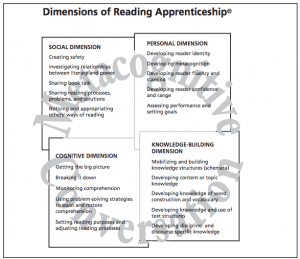 Last weekend I spent time at the Metacognition and Mindfulness: the Fourth Annual Reading Apprenticeship Conference. I am going to break this experience up into a couple of separate posts because even though the conference was only a day and a half, there was a LOT packed into it. If you are not familiar with Reading Apprenticeship, it is important to get to that definition first. According to the conference page: “Reading Apprenticeship at WestEd is a research-based framework that helps community college faculty members support students to become motivated, strategic, and critical readers, thinkers, and writers. Colleges implementing Reading Apprenticeship find that it can produce a dramatic, positive transformation of students’ engagement and achievement not only in literacy, but also in learning across all academic disciplines.”
Last weekend I spent time at the Metacognition and Mindfulness: the Fourth Annual Reading Apprenticeship Conference. I am going to break this experience up into a couple of separate posts because even though the conference was only a day and a half, there was a LOT packed into it. If you are not familiar with Reading Apprenticeship, it is important to get to that definition first. According to the conference page: “Reading Apprenticeship at WestEd is a research-based framework that helps community college faculty members support students to become motivated, strategic, and critical readers, thinkers, and writers. Colleges implementing Reading Apprenticeship find that it can produce a dramatic, positive transformation of students’ engagement and achievement not only in literacy, but also in learning across all academic disciplines.”
According to the WestEd literature “Reading Apprenticeship is an approach to reading instruction that helps young people develop the knowledge, strategies, and dispositions they need to become more powerful readers. It is at heart a partnership of expertise, drawing on what teachers know and do as discipline-based readers, and on adolescents’ unique and often underestimated strengths as learners. Reading Apprenticeship helps students become better readers by:
- engaging students in more reading—for recreation as well as for subject-area learning
and self-challenge; - making the teacher’s discipline-based reading processes and knowledge visible to students;
- making students’ reading processes, motivations, strategies, knowledge, and understandings visible to the teacher and to one another;
- helping students gain insight into their own reading processes; and
- helping them develop a repertoire of problem-solving strategies for overcoming obstacles and deepening comprehension of texts from various academic disciplines.”
According to my reading of the text “Reading for Understanding,” these strategies are probably familiar to anyone who has been around developmental education, composition instruction, or Adult Basic Education over the last 20 years or so: they include a lot of active learning techniques combined with Constructivist teaching strategies. What is different is that the techniques and research are all in one tool chest. And the techniques focus on the students’ metacognition: their active engagement with their own thinking processes.
Again, according to WestEd, Reading Apprenticeship involves teachers in orchestrating and integrating four interacting dimensions of classroom life that support reading development. These dimensions are woven into subject-area teaching through metacognitive conversations— conversations about the thinking processes students and teachers engage in as they read. These dimensions are the Social, Personal, Cognitive, and Knowledge-Building:
- Social: The social dimension draws on adolescents’ interests in peer interaction as well as larger social, political, economic, and cultural issues. A safe environment is created for students to share their confusion and difficulties with texts, and to recognize the diverse perspectives and resources brought by each member.
- Personal: This dimension draws on strategic skills used by students in out-of-school settings; their interest in exploring new aspects of their own identities and self-awareness as readers; and their purposes for reading and goals for reading improvement.
- Cognitive: The cognitive dimension involves developing readers’ mental processes, including their repertoire of specific comprehension and problem-solving strategies. Importantly, the work of generating cognitive strategies that support reading comprehension is carried out through classroom inquiry.
- Knowledge-Building: This dimension includes identifying and expanding the knowledge readers bring to a text and further develop through personal and social interaction with that text, including knowledge about word construction, vocabulary, text structure, genre, language, topics and content embedded in the text.

“In Metacognitive Conversation, these four dimensions are integrated as teachers and students work collaboratively to make sense of texts, while simultaneously engaging in a conversation about what constitutes reading and how they are going about it. This metacognitive conversation is carried on both internally, as teacher and students reflect on their own mental processes, and externally, as they share their reading processes, strategies, knowledge resources, motivations, and interactions with, and affective responses to texts.”
I am not a huge fan of proprietary, copy-righted texts but to WestEd’s credit, they have put a lot of material online to support the model.
In my next few posts, I will look at some of these strategies as they were shared at the conference by my colleagues who presented there.




